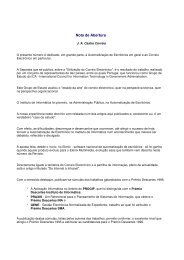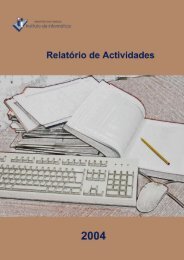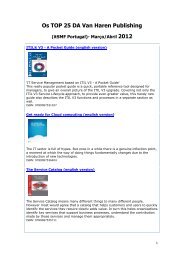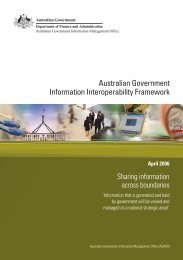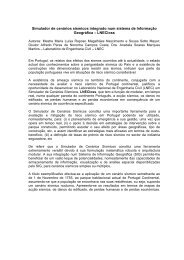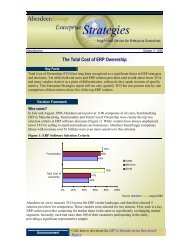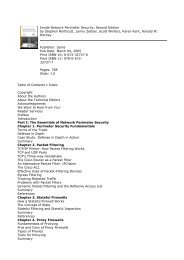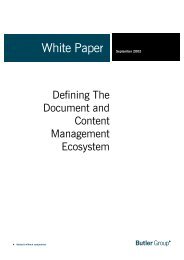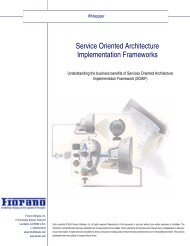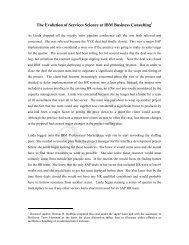OECD Peer Review of E-Government in Denmark - ePractice.eu
OECD Peer Review of E-Government in Denmark - ePractice.eu
OECD Peer Review of E-Government in Denmark - ePractice.eu
You also want an ePaper? Increase the reach of your titles
YUMPU automatically turns print PDFs into web optimized ePapers that Google loves.
e-Income<br />
Another good example <strong>of</strong> Danish efforts to develop common <strong>in</strong>frastructure and applications is<br />
provided by the e-Income system. It has been developed to address a number <strong>of</strong> problems experienced<br />
by government, employers and citizens <strong>in</strong> relation to provision and use <strong>of</strong> <strong>in</strong>formation about <strong>in</strong>comes<br />
by government. For government, payment <strong>of</strong> <strong>in</strong>come-related welfare benefits has <strong>of</strong>ten been based on<br />
<strong>in</strong>adequate <strong>in</strong>formation about people’s <strong>in</strong>come. This can result <strong>in</strong> payment errors, and create<br />
opportunities for benefit fraud. For employers, the fact that they have to report <strong>in</strong>come <strong>in</strong>formation to<br />
a range <strong>of</strong> government organisations creates a large adm<strong>in</strong>istrative burden. For citizens, <strong>in</strong>formation<br />
deficiencies <strong>in</strong> this area can lead to <strong>in</strong>accurate benefit payments, sometimes creat<strong>in</strong>g a risk <strong>of</strong> citizens<br />
becom<strong>in</strong>g unwitt<strong>in</strong>gly <strong>in</strong>debted to the State.<br />
The solution to this problem has been to establish what is called the e-Income Register, a<br />
common database <strong>in</strong>to which employers provide <strong>in</strong>formation about employee <strong>in</strong>come and work<strong>in</strong>g<br />
hours. This <strong>in</strong>formation is used across the public sector <strong>in</strong> support <strong>of</strong> those functions to which the<br />
<strong>in</strong>formation relates. This new arrangement delivers benefits by: 1) reduc<strong>in</strong>g employers’ report<strong>in</strong>g<br />
burden; 2) <strong>in</strong>creas<strong>in</strong>g the accuracy <strong>of</strong> citizens’ benefit entitlements and payments; 3) reduc<strong>in</strong>g<br />
government’s <strong>in</strong>formation collection costs; and 4) <strong>in</strong>creas<strong>in</strong>g the overall accuracy <strong>of</strong> operations.<br />
e-Procurement<br />
Like many <strong>OECD</strong> countries, <strong>Denmark</strong> has made efforts to apply e-government to the bus<strong>in</strong>ess <strong>of</strong><br />
public procurement. The Danish Public Procurement Portal (DOIP) is an electronic marketplace to<br />
which both private and public purchasers and their suppliers have access. Launched <strong>in</strong> early 2002<br />
under the <strong>in</strong>itiative <strong>of</strong> the MVTU, the DOIP is an example <strong>of</strong> the typical Danish approach to<br />
partner<strong>in</strong>g with the private sector to develop e-government. The public sector has not directly <strong>in</strong>vested<br />
<strong>in</strong> establishment <strong>of</strong> the DOIP, which has <strong>in</strong>stead been developed and is owned by a consortium <strong>of</strong><br />
Maersk Data, Danske Bank, Post <strong>Denmark</strong> and the telecom company TDC. The DOIP is operated by<br />
an entity they have created called “gatetrade.net”, and the public sector simply pays fees for us<strong>in</strong>g the<br />
system.<br />
The Agency for <strong>Government</strong>al Management acts as co-ord<strong>in</strong>ator <strong>of</strong> government <strong>in</strong>terests <strong>in</strong> the<br />
DOIP, focus<strong>in</strong>g on issues related to functionality, <strong>in</strong>terfaces, security and transaction costs. Use <strong>of</strong> the<br />
DOIP portal is not mandatory, but is recommended for all government agencies. Some regional and<br />
local authorities make use <strong>of</strong> private marketplaces, and the State-owned company National<br />
Procurement Ltd. (SKI) has also set up a simple e-tender<strong>in</strong>g system (ETHICS, Net<strong>in</strong>dkøb and<br />
Netkatalog).<br />
Common frameworks<br />
In addition to hav<strong>in</strong>g some common ICT <strong>in</strong>frastructures <strong>in</strong> place, <strong>Denmark</strong> has also been at the<br />
forefront <strong>of</strong> government efforts to develop common frameworks to support e-government<br />
collaboration, as outl<strong>in</strong>ed below.<br />
Enterprise architecture<br />
Currently, the most prom<strong>in</strong>ent <strong>of</strong> these common frameworks is the Danish enterprise architecture.<br />
This architecture is <strong>in</strong>tended to provide the common conceptual framework for design <strong>of</strong> ICT solutions<br />
<strong>in</strong> the public sector. Work on its development began <strong>in</strong> late 2002, when the MVTU circulated the<br />
Green Paper on Enterprise Architecture for public consultation. The green paper asked three key<br />
questions: 1) did government need a common framework for enterprise architecture; 2) how could<br />
103



